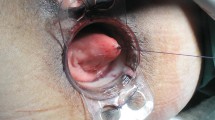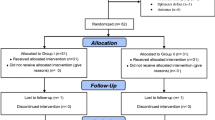Abstract
A prospective clinical, manometric, electromyographic and radiological study was conducted to judge the degree of success achieved with anterior-posterior rectopexy in 18 female patients suffering from obstructed defecation and varying degrees of incontinence. Prior to being operated on, 6 of the patients showed symptoms of intussusception, 4 an internal prolapse of the anterior rectum wall, and 5 a rectocele at least 2 cm in size; all of them had significant perianal descent. The main aim of this study was more precise definition of the pre- and postoperative bowel evacuation using a defecation index. This study shows that obstructed defecation is significantly associated with a lasting feeling of needing to defecate after evacuation, a sensation of incomplete evacuation, perianal pain and necessity for manual support during defecation. The patients had a mean age of 62 (range, 38–78) years. All underwent anterior-posterior rectopexy (Ivalon or Vicryl) with posterior pelvic repair of the puborectalis muscle. In 2 patients rectopexy was combined with sigmoidectomy, in 11 cases, with left hemicolectomy, and in 2, with subtotal colectomy. The median follow-up was 40.8 months (range, 6–66 months). Postoperatively anorectal manometry showed a significant increase in the resting anal pressure and the maximum voluntary pressure (P = 0.05). Continence was improved in 10 patients (55%), 7 (39%) of whom regained normal continence. No significant change in pelvic descent or anorectal angle was observed. Only 8 patients reported a complete evacuation of the rectum postoperatively.
Zusammenfassung
Diese prospektive klinische, manometrische, elektromyographische and radiologische Studie wurde durchgeführt, um den Erfolg der anteriorposterioren Rektopexie bei 18 weiblichen Patienten mit obstruktiven Defäkationsstörungen und unterschiedlichen Graden von Inkontinenz beurteilen zu können. Präoperativ wiesen 6 der Patientinnen eine rektale Intussuszeption, 4 einen inneren Prolaps der Rektumvorderwand und 5 eine Rektozele von mindestens 2 cm Größe auf. Alle hatten eine signifikante Beckenbodensenkung. Das Hauptziel dieser Studie war, durch Anwendung eines Defäkationsindexes die prä- und postoperative Darmentleerung besser beurteilen zu können. Diese Studie zeigt, daß die obstruktive Defäkation signifikant mit einem anhaltenden Stuhldranggefühl nach der Entleerung, einem Gefühl der unvollständigen Entleerung, perianalen Schmerzen und der manuellen Unterstützung bei der Entleerung verbunden ist. Alle Patienten, Durchschnittsalter 62 Jahre, unterzogen sich einer anterior-posterioren Rektopexie (Ivalon oder Vicryl) in Verbindung mit einem posterioren Pelvic-repair des M. puborectalis. Bei 2 Patienten wurde gleichzeitig eine Sigmoidektomie durchgeführt, in 11 Fällen wurde die Rektopexie mit einer Hemikolektomie links kombiniert und in 2 Fällen mit einer subtotalen Kolektomie. Die mittlere Follow-up-Zeit betrug 40,8 Monate (Spanne: 6–66 Monate). Postoperativ zeigte sich in der anorektalen Manometrie ein signifikanter Anstieg des Analdrucks in Ruhe and bei willkürli-cher Kontraktion. Die Kontinenz wurde bei 10 Patienten (55%) verbessert, 7 (39%) Patienten erlangten wieder die volle Kontinenz. Keine signifikanten Veränderungen zeigten der anorektale Winkel and der perineale Deszensus. Nur 8 Patienten berichteten postoperativ über eine vollständige Entleerung des Rektums bei der Defäkation.
Similar content being viewed by others
Literatur
Athanasiadis S (1992) Elektromyographische und funktions-analytische Befunde bei obstruktiven Defäkationsstörungen. Ein Beitrag zur Differenzierung der neurogenen von den myogenen Sphinkterschäden. Langenbecks Arch Chir 377:244–252
Athanasiadis S, Heiligers J, Kossivakis D (1992) Anteriore und posteriore Rektopexie mit Levatorraffung bei Patienten mit Rektumprolaps und Inkontinenz. Langenbecks Arch Chir 377:288–294
Asman HB (1957) Internal procidentia of the rectum. South Med J 50:641
Barnes PR, Hawley PR, Preston DM, Lennard-Jones JE (1985) Experience of posterior division of the puborectalis muscle in the managemant of chronic constipation. Br J Surg 1895:475–477
Bartolo DCC, Roe AM, Virjee J, Mortensen NJ, Locke-Edmonds JC (1988) An analysis of rectal morphology in obstructed defecation. Int J Colorectal Dis 3:17–22
Berman IR, Harris MS, Rabeler MB (1990) Delorme's transrectal excision for internal rectal prolapse: Patient selection, technique, and three-year follow-up. Dis Colon Rectum 33:573–580
Broden G, Dolk A, Holmström B (1988) Recovery of the internal anal sphincter following rectopexy: A possible explanation for continence improvement. Int J Colorectal Dis 3:25–28
Finlay G, Brown D (1988) Posterior pelvic floor repair — a new surgical approach for outlet obstruction constipation (obstructed defecation). Gut 29: A1456
Girona J, Narro JL (1986) Chirurgische Behandlung des Descending Perineum Syndroms. Aktuel Coloproktol 3:57–64
Holmström B, Broden G, Dolk A, Frenckner B (1986) Increases in anal resting pressure following the Ripstein operation: A contribution to continence? Dis Colon Rectum 29:485–487
Ihre T, Seligson U (1975) Intussusception of the rectum — internal procidentia: Treatment and results in 90 patients. Dis Colon Rectum 18:391–396
Johansson C, Ihre T, Ahlbäck SO (1985) Disturbances in the defecation mechanism with special referende to intussusception of the rectum (internal procidentia). Dis Colon Rectum 28:920–924
Johansson C, Ihre T, Holmström B, Nordstrom E, Dolk A, Borden G (1990) A combined electromyographic and cineradiologica investigation in patients with defecation disorders. Dis Colon Rectum 33:1009
Keighley MRB, Shouler P (1984) Outlet syndrome: Is there a surgical option? J R Soc Med 77:559–563
Keighley MRB, Shouler P (1984) Clinical and manometric features of the solitary rectal ulcer syndrome. Dis Colon Rectum 27:507–512
Kiff ES, Barnes PRH, Swash M (1984) Evidence of pudental neuropathy in patients with perineal descent and chronic straining at stool. Gut 25:1279–1282
Kuijpers HC, Bleijenberg G (1985) The spastic pelvic floor syndrome. Dis Colon Rectum 28:669
Lux N, Athanasiadis S, Fischbach N, Meyer B (1992) Funktionelle Ergebnisse nach subtotaler und partieller Colektomie bei der Therapie resistenter chronischer Obstipation. Eine Follow-up Studie bei 32 Patientinnen. Chirurg 63:739
Martelli H, Devroede G, Arhan P, Duguay C (1978) Mechanisms of idiopathic constipation: Outlet obstruction. Gastroenterology 75:623–631
McCue JL, Thomson JPS (1990) Rectopexy for internal rectal intussusception. Br J Surg 77:632–634
Nicholas RJ, Samson JN (1986) Anteroposterior rectopexy in the treatment of solitary rectal ulcer syndrome without overt rectal prolapse. Br J Surg 73:222–224
Orrom WJ, Bartolo DCC, Miller R, Mortensen NJ, McC, Roe AM (1991) Rectopexy is an ineffective treatment for obstructed defecation. Dis Colon Rectum 34:41–46
Parks AG, Porter NH, Hardcastle J (1966) The syndrome of the descending perineum. Proc R Soc Med 59:477
Pinho M, Yoshioka K, Keighley MRB (1989) Long term results of anorectal myectomy for chronic constipation. Br J Surg 76:1163–1164
Ripstein CB (1975) Procidentia of the rectum: internal intussusception of the rectum (Stage I rectal prolapse). Dis Colon Rectum 18:458
Rutter KRP (1974) Electromyographic abormalities in various pelvic floor abnormalities. Proc R Soc Med 67:53
Shafik A (1983) Neues Konzept der Anatomie des analen Spinktermechanismus und der Physiologic der Defakation. XVIII. Das Levator-Dysfunktionssyndrom. Coloproctol 3:158–165
Shafik A (1990) Ein neues Konzept der Anatomic des analen Sphinktermechanismus und der Physiologic der Defakation. XLII: Rektopuborektaler Reflex. Coloproctol 12:170–172
Smith AN, Varma JS, Binnie NR, Papachrysostomou M (1990) Disordered colorectal motility in intractable constipation following hysterectomy. Br J Surg 77:1361–1366
Snooks SJ, Setchell M, Swash M,. Henry MM (1984) Injury to the innervation of pelvic floor sphincter musculature in childbirth. Lancet II:546–550
Snooks SJ, Barnes PRH, Swash M, Henry MM (1985) Damage to the innervation of the pelvic floor musculature in chronic constipation. Gastroenterology 89:977–981
Speakman CTM, Madden MV, Nicholls RJ, Kamm MA (1991) Lateral ligament division during rectopexy causes constipation but prevents recurrence: Results of a prospective randomized study. Br J Surg 78:1431–1433
Wells C (1959) New operation for rectal prolapse. Proc R Soc Med 52:602
Wexner SD, Daniel N, Jagelman DG (1991) Colectomy for constipation: Physiologic investigation is the key to success. Dis Colon Rectum 34:851–856
White CM, Findlay JM, Price JJ (1980) The occult rectal prolapse syndrome. Br J Surg 67:528
Author information
Authors and Affiliations
Rights and permissions
About this article
Cite this article
Athanasiadis, S., Heiligers, J. Der Wert der abdominalen Rektopexie bei obstruktiven Defäkationsstörungen. Langenbecks Arch Chir 378, 92–101 (1993). https://doi.org/10.1007/BF00202116
Received:
Issue Date:
DOI: https://doi.org/10.1007/BF00202116




